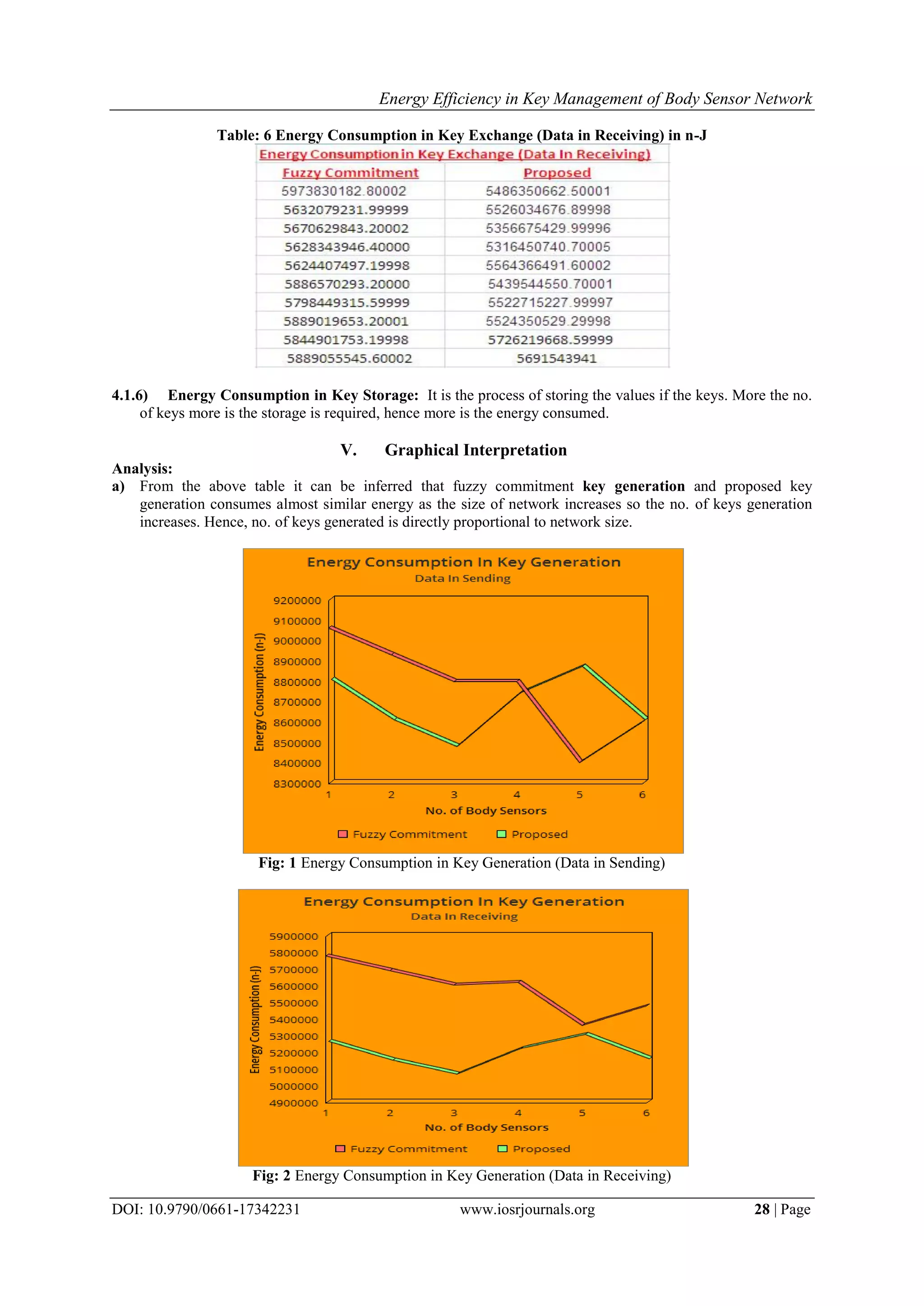This document summarizes a research paper that proposes a new algorithm for maintaining the shape and integrity of bio-signals over a body sensor network. The algorithm uses set theory operations instead of interpolation to synchronize signals. It also proposes a secure key management scheme to enhance security in wireless body area networks and analyzes energy consumption. The paper reviews related work in body sensor networks, describes the methodology used in the research, and presents results on evaluating the proposed algorithm's energy efficiency and effectiveness compared to previous methods.
![IOSR Journal of Computer Engineering (IOSR-JCE)
e-ISSN: 2278-0661,p-ISSN: 2278-8727, Volume 17, Issue 3, Ver. IV (May – Jun. 2015), PP 22-31
www.iosrjournals.org
DOI: 10.9790/0661-17342231 www.iosrjournals.org 22 | Page
Energy Efficiency in Key Management of Body Sensor Network
Shilpa Bansal1
, Prof. Dinesh Kumar2
1
(Mtech-CSE Student, GZS-PTU Campus, Bathinda, Punjab, India)
2
(Assistant Professor Department of CSE, GZS-PTU Campus, Bathinda, Punjab, India)
Abstract: In this research, we have developed an algorithm that maintains the shape and integrity of the Bio-
Signal over Body- Sensor Network. A new approach has been experimented successfully using set theory
operators (union, intersection, complement, Cartesian product) instead of using traditional interpolation
method for maintenance of original properties of Bio-signal and synchronization. A secure key management
scheme is used to enhance the security of wireless body area network (WBAN) and energy analysis is also done.
The operational resources of biosensor nodes in BSNs are very restricted, and traditional security technologies
are not directly applicable to BSNs. Due to characteristics of biosensors, time synchronization and low-energy
communication are two challenging problems for BSNs. Various cryptography techniques are employed in
order to provide security as the information exchanged during health monitoring are highly sensitive and
require strict protection from unauthorized access.
Keywords: Body Sensor Network, Energy Consumption.
I. Introduction
The data generated from the continuous monitoring [3] from the body sensors consist of sequence of
data items thereafter referred to as a data stream. Data stream generally enter the program of monitoring stream
from multiple body sensors, each data item is processed for limited time period before it is discarded or
analyzed. Many medical devices have added [10] communication capabilities into existing products. In typical
scenario, access point would act as a patient-side hub, which relays stored readings form medical devices to
remote center for store and forward monitoring, analysis and disease management. The main function is to
measure or determine the [15] presence of some physical quantity that may be useful for diagnostic purposes.
The choice of proper parameters which have high information content is an important issue in the patient
monitoring system. One of the wireless standards known as advanced and adaptive network technology (ANT)
[16] has received significant attention especially for sports and health application. The system consist of ECG,
signal collection node, blood oxygen signal [7] collection node, inertial sensor node, receiving node and upper
computer software. The 3 nodes collect ECG signals, blood O2 signal, motion signals. The collected signals are
transmitted wirelessly to receiving node and analyzed by software in computer in real time. The structure of
data stream need to be in steady state, in regular and predictable order [19]. The data from body sensors must
allow dynamic modification occasionally [17] (key management/exchange) etc. Sometimes, re-initialization,
rebooting, time lag occurs due to multiple reasons. High performance is expected, in real time [3] constrain that
must be satisfied by specific health application in terms of latency/throughput. In Wireless body area network
(WBAN) [8], small electronic devices are attached with human body to monitor specific health related problem
such as blood sugar level, organ movement etc. It has high cost of synchronization. The data stream generated
by body sensors is basically a Time Series Data Set. A wireless sensor node generally has limited storage and
computation capabilities, [4] also severely constrained power supplies. Limited work is reported on identifying
anomalies in such kind of time series database, which result in low commitment in synchronization. There a
reference based time series analysis is required so that, the shape of bio signals remain intact. There are three
possible ways of synchronization: Union, Intersection and Uniform. These methods offer a better alternative to
interpolation method as reference or perfect time series is used for shape and synchronization of the bio signals.
However, energy consumption need to be observed and taken into consideration for selecting one of the best out
of these three methods. Another thing that becomes extremely important is security [18], when wireless sensor
network are deployed in a hostile environment. In order to provide security, wireless communication should be
authenticated and encrypted. Key management is the main problem in wireless sensor network (WSN) when
concentrated on security. The key management scheme proposed should be scalable to increase in sensor nodes
substantially and also its dynamic nature.
II. Related Work
In this section, we have solicited some journals. From basics to advanced knowledge is analyzed in it.
1) In this paper, a data logger was designed to have 4 layers i.e. application, disc operating system, driver,
hardware. Each layer completes its functionality by using the resources of its lower layers. By only](https://image.slidesharecdn.com/e017342231-160701072506/75/E017342231-1-2048.jpg)








![Energy Efficiency in Key Management of Body Sensor Network
DOI: 10.9790/0661-17342231 www.iosrjournals.org 31 | Page
consumption. The key goal is to reduce the data transmission cost which is achieved by proposed scheme which
can be easily depicted from the graphs and in the results shown.
Future Scope
The Body Sensor Networks runs without human intervention, they need machine-to-machine
authentication protocol to maintain security. Therefore, future work may be preceded in the direction of building
protocols that incorporate ‘zero proof’ algorithms. Also, the above proposed scheme is limited to a bounding
environment within a particular environment. Therefore, the future direction of this research is to devise an
algorithm for the unbounded environment in which patient moves freely and may get in range of other BSN in
the outside environment and then couple it with the synchronization and energy efficient algorithm to form a
complete energy efficient key management scheme.
References
[1]. Khan, Tareq Hasan, and Khan A. Wahid. "An advanced physiological data logger for medical imaging applications." EURASIP
Journal on Embedded Systems 2012, no. 1 (2012): 1-14.
[2]. Chen, Min, Chin-Feng Lai, and Honggang Wang. "Mobile multimedia sensor networks: architecture and routing." EURASIP
Journal on Wireless Communications and Networking 2011, no. 1 (2011): 1-9.
[3]. Quwaider, Muhannad, Mahmoud Taghizadeh, and Subir Biswas. "Modeling on-body dtn packet routing delay in the presence of
postural disconnections." EURASIP journal on wireless communications and networking 2011 (2011): 3.
[4]. Begonya, Otal, Alonso Luis, and Verikoukis Christos. "Design and analysis of an energy-saving distributed mac mechanism for
wireless body sensor networks." EURASIP Journal on Wireless Communications and Networking 2010 (2010).
[5]. Le, T.Q.; Changqing Cheng; Sangasoongsong, A.; Wongdhamma, W.; Bukkapatnam, S.T.S., "Wireless Wearable Multisensory
Suite and Real-Time Prediction of Obstructive Sleep Apnea Episodes," Translational Engineering in Health and Medicine, IEEE
Journal of , vol.1, no., pp.2700109,2700109, 2013
[6]. Rebolledo-Mendez, Genaro, Angelica Reyes, Sebastian Paszkowicz, Mari Carmen Domingo, and Lee Skrypchuk. "Developing a
body sensor network to detect emotions during driving." Intelligent Transportation Systems, IEEE Transactions on 15, no. 4 (2014):
1850-1854.
[7]. Zhao, Cong, and Sen Qiu. "A system of human vital signs monitoring and activity recognition based on body sensor network."
(2014).
[8]. Alrajeh, Nabil Ali, Jaime Lloret, and Alejandro Canovas. "A Framework for Obesity Control Using a Wireless Body Sensor
Network." International Journal of Distributed Sensor Networks 2014 (2014).
[9]. Sala, Marco, Paolo Cunzolo, and Diego Barrettino. "Body sensor network for posturometric studies." In Instrumentation and
Measurement Technology Conference (I2MTC) Proceedings, 2014 IEEE International, pp. 536-541. IEEE, 2014.
[10]. Hung, Kevin, C. C. Lee, and Sheung-On Choy. "Ubiquitous Health Monitoring: Integration of Wearable Sensors, Novel Sensing
Techniques, and Body Sensor Networks." In Mobile Health, pp. 319-342. Springer International Publishing, 2015.
[11]. Kantoch, E., P. Augustyniak, M. Markiewicz, and D. Prusak. "Monitoring activities of daily living based on wearable wireless body
sensor network." In Engineering in Medicine and Biology Society (EMBC), 2014 36th Annual International Conference of the
IEEE, pp. 586-589. IEEE, 2014.
[12]. Sudha, G. Florence, S. Karthik, and N. Selva Kumar. "Activity aware energy efficient priority based multi patient monitoring
adaptive system for body sensor networks." Technology and Health Care 22, no. 2 (2014): 167-177.
[13]. Dangi, Kusum Grewal, and Supriya P. Panda. "Challenges in Wireless Body Area Network-A survey." In Optimization, Reliabilty,
and Information Technology (ICROIT), 2014 International Conference on, pp. 204-207. IEEE, 2014.
[14]. Subudhi, Ch Sandeep Kumar, and S. Sivanandam. "Intelligent Wireless Patient Monitoring and Tracking System (Using Sensor
Network and Wireless Communication)." International Journal 1, no. 3 (2014): 97-104.
[15]. Gharghan, Sadik Kamel, Rosdiadee Nordin, and Mahamod Ismail. "Design Consideration of an Energy Efficient Wireless Sensor
Network for High Performance Track Cycling." In Information Science and Applications (ICISA), 2014 International Conference
on, pp. 1-5. IEEE, 2014.
[16]. Nagarajan, N., and Ahmad Taher Azar. "An Improved Key Management Scheme with High Security in Wireless Sensor Networks."
In Bio-inspiring Cyber Security and Cloud Services: Trends and Innovations, pp. 249-264. Springer Berlin Heidelberg, 2014.
[17]. Movassaghi, Samaneh, Mehran Abolhasan, Justin Lipman, David Smith, and Abbas Jamalipour. "Wireless body area networks: a
survey." (2014): 1-29.
[18]. Mukhopadhyay, S. "Wearable Sensors for Human Activity Monitoring: A Review." (2015).
[19]. Meena, R., S. Ravishankar, and J. Gayathri. "Monitoring Physical Activities Using WBAN." International Journal of Computer
Science & Information Technologies 5, no. 4 (2014).](https://image.slidesharecdn.com/e017342231-160701072506/75/E017342231-10-2048.jpg)